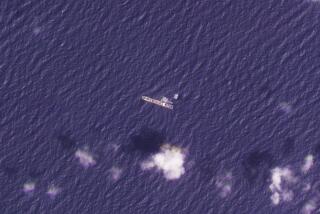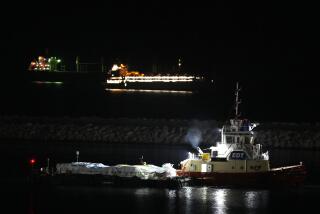Quick Fix : 2 New Hospital Ships Will Follow Troops; Each Boasts 12 Operating Rooms, 1,000 Beds
- Share via
When Navy Secretary John F. Lehman Jr. and his top advisers met in 1981 to map long-term military strategy, they were startled to learn that blueprints for a 600-ship Navy did not include a single hospital vessel to treat servicemen wounded in the event of war.
“We found we had no way to care for casualties,” Lehman recalled in a recent interview. “There were just no plans . . . when you’re in Europe, in the Pacific or wherever the fighting may be, you’re just not close to a hospital.”
Today, the results of that Pentagon brainstorming session can be seen in San Diego Bay--two gigantic ships with red crosses on the outside and enough room on the inside for 1,000 beds apiece. Nearly three football fields in length, each ship contains 12 operating rooms, intensive-care wards for 80 patients, a morgue with 22 spaces and landing pads large enough to accommodate the military’s largest transport helicopters.
At a combined price tag of $510 million, the hospital ships Mercy and Comfort signal a major advance in the Reagan Administration’s push for military readiness and superiority. Not since the period between World War II and the Korean War has the Navy maintained a hospital vessel in peacetime. In the past, the United States waited until the outbreak of war before converting liners and freighters into hospital ships and rushing them to combat areas.
“It does signify a change both in priorities and in philosophy,” Adm. Carlisle A.H. Trost, the chief of naval operations, said in an interview last week. “The whole idea in combat is to return the casualty who doesn’t require long-term hospitalization to his operational unit as quickly as possible.
“We’d gotten to the point where our ability for caring for casualties on a mass scale had really declined to the point of near nonexistance.”
Due for delivery to the fleet within the next six months, the two ships will be larger than all but a few land-based hospitals. By comparison, the average U.S. hospital has 300 beds, and only a handful of facilities have enough space to care for 1,000 patients, according to the American Hospital Assn.
“There is no other country that has anything like this capability,” Dr. William Mayer, the assistant defense secretary for health affairs, said earlier this year. “These things are truly unique. This is American medicine at its finest aboard a ship that can be put any place in the world.”
The hospital ships are being converted from 90,000-ton San Clemente class supertankers, a first for the Navy and the contractor, National Steel and Shipbuilding Co. of San Diego.
The Navy initially planned to put the Mercy and Comfort on standby status in Oakland and Norfolk, Va., and assign skeleton crews to maintain the ships in case of war or another emergency.
But last month, President Reagan announced he will send the Mercy to the Philippines as part of a $10-million emergency aid package. The ship and its crew of military doctors and nurses are scheduled to spend four months early next year operating a general outpatient clinic for citizens of the Philippines and South Pacific.
They are expected to treat a variety of cases including malaria, strep throat, eye diseases and basic dental work.
The “humanitarian mission” was first proposed by Adm. James A. Lyons, commander of the U.S. Pacific Fleet in Hawaii.
“I looked at what was going on in the Philippines and some of the promises Mrs. (Corazon) Aquino had made to the Philippine people, and it seemed to me that she needed some early successes if we were going to sustain the atmosphere of hope,” Lyons said in an interview.
Lyons denied that the trip was planned to bolster the United States’ image among Filipinos or to improve the military’s chances of renegotiating its agreement to operate naval bases in the Philippines, which expires in 1991.
“This is part of helping rebuild the nation,” Lyons said. “I wouldn’t want to draw a direct relationship between this effort (and the lease agreement). This is done in helping to restore and build a viable democracy in the Philippines.”
The Philippines relief project promises numerous logistical problems.
Every feature of the Mercy--from the helicopter landing pads to the built-in oxygen lines running to the beds--was designed solely to provide emergency surgical care to wartime casualties, not to dispense routine medical care, according to Navy officials.
In preparation for the relief effort, Nassco workers are figuring out how to convert the Mercy’s medical wards into waiting rooms and how to provide access for civilian patients to board the massive hospital ship, said Fred Hallet, a company spokesman.
The Navy is studying the possibility of assigning a helicopter squadron to transport patients because the hospital ship is too large to dock in most ports and islands in the Philippines and South Pacific, officials said.
In addition, the use of military doctors and nurses aboard the Mercy will likely reduce the level of health care at overcrowded medical facilities for American military personnel and their dependents. To ease the burden, Navy officials have announced plans to use Filipino physicians on the Mercy and to fly U.S. medical personnel to the Philippines to meet the ship so they won’t waste time sailing across the ocean.
The Navy sent an advance team to the Philippines earlier this month to iron out the ship’s schedule and to resolve any problems that may arise, officials said.
Trost said the tour of the Philippines will give Navy personnel an opportunity to become familiar with the hospital ship. But after the trip, the Navy’s top uniformed officer said, he will urge that the two hospital ships remain in port on standby status, despite the “great temptation” to send them around the world on other relief missions.
“They are not really designed for the type of operation the Mercy is going on,” Trost said. “ . . . It’s geared to bring large numbers of serious casualties on board and handle them. It’s a casualty hospital. . . .
“So really, the intent was (to be) poised and ready for a primary mission, which is not going around being a humanitarian asset.”
When Navy officials lobbied Congress in the early 1980s to set aside half a billion dollars for the two ships, no one envisioned using the Mercy to treat civilians in the Philippines, according to a Navy spokesman in Washington.
The Navy, which had not built a hospital ship since World War II, argued that it needed the Mercy and the Comfort to participate in emergencies or long-term conflicts.
The ships “also add to the comfort and well-being of the Marine who is being told, ‘You might go ashore in a hostile situation,’ ” Trost said. “He knows that, if something does happen to him, his care is right there on the horizon or even closer.”
One of the early supporters for the ships was Sen. Pete Wilson (R-Calif.), then a new face on the Senate Armed Services Committee. In an interview last week, Wilson said he was surprised the Navy did not have one hospital ship in its fleet. After the Vietnam War, the hospital ships Sanctuary and Repose were taken out of service.
Trost blamed the lack of a hospital ships on “a combination of budget priorities” and “benign neglect.”
Though persuading his Senate colleagues to build the hospital ships was “not too hard a sell,” Wilson said, the expense was another matter.
“We were concerned about money,” Wilson said. “If (the Navy) couldn’t do it within a certain budget, it just wasn’t going to get done.”
By proposing to convert existing ships, the Navy saved at least $100 million per vessel and several years of construction time, Lehman said. Naval engineers recommended using supertankers because their low center of gravity enhances the ship’s anti-roll stability, for the comfort of crews and patients.
Nassco submitted a winning bid of $400 million to do the job in San Diego. Included in the bid was the cost of purchasing the supertankers Worth and Rose City from Apex Marine Corp. of New York. Nassco built the two supertankers in 1976 to haul Mideast crude oil through the Suez Canal.
The Navy spent an additional $110 million to outfit the ships with medical equipment.
Nassco began the conversion process on Mercy in July, 1984, by ripping out 13 miles of piping and 3,200 tons of steel from the inside, leaving only the shell, engine room and bulkheads intact.
Workers rebuilt the Mercy using an assembly-line method taken from Japanese and South Korean shipyards. This “block” building technology allowed steelworkers, electricians and plumbers to work together to assemble, for instance, a 171-ton toilet and shower module. The unit was then placed inside the ship’s hull using three heavy cranes and welded onto the appropriate deck.
In all, 200 such pre-outfitted blocks were installed on the ship.
Features on both hospital ships include a satellite lab, pharmacy, library, gymnasium, physical therapy equipment, eyeglass center and barber shop. The ships also have four distilling plants, each capable of producing 75,000 gallons of fresh water a day.
The wide hallways, ramps, elevators and brightly colored walls make the ships appear from the inside like any large, modern hospital. Each of the 80 beds in the intensive-care unit is equipped with piped oxygen, suction and a computerized monitoring system.
Each ship will have a complement of 14 officers and 54 sailors, but the proposed medical staff and support crew will number 1,192.
The Comfort is undergoing sea trials and will be delivered to the Navy next spring. The Mercy will be commissioned Nov. 8 and is scheduled to sail for the Philippines in March.
Lyons said he first proposed his relief project to Filipino leaders, U.S. Embassy officials in Manila and the Defense Department. All expressed support.
Mayer, the assistant defense secretary, has in recent months become one of the military’s most enthusiastic boosters of using the hospital ship for an international relief effort.
“This is a message with three big red crosses on the side and a great big American flag that we care,” Mayer said.
Under the plan, military medical teams assigned to the Mercy will establish hospital camps on shore before deciding to treat some patients there or to send them to the ship for more sophisticated care.
“You’ve got 1,000 islands in the Philippines,” Lyons said. “The only thing that we’re not prepared to do . . . is chronic cases that require long periods of hospitalization. That is not the mission. This is . . . an up-front type of thing.
“This isn’t just throwing money at a problem. This is the involvement of people, and people turn out to be our best goodwill ambassadors.”
Lyons said the voyage will “shake down” the Mercy to make certain that all parts of the ship are in working order.
“Perhaps it will pay large dividends when she has to perform her principal mission, which we hope is never,” Lyons said.
More to Read
Sign up for Essential California
The most important California stories and recommendations in your inbox every morning.
You may occasionally receive promotional content from the Los Angeles Times.













